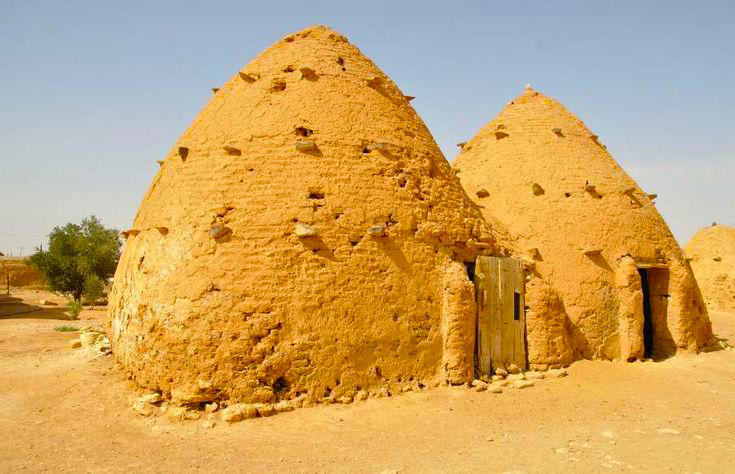Beehive Houses in Syria: Architecture of Clay and History – Syria is a land rich in cultural heritage and architectural marvels, ranging from ancient Roman ruins to magnificent Islamic monuments. Among these diverse legacies, one of the most unique and fascinating forms of vernacular architecture is the Beehive Houses in Syria—also known as Mud Domes or Clay Domes. Found primarily in the rural areas east of Hama, especially around the town of Salamiyah, these distinctive homes are a testament to human ingenuity, adaptation, and tradition.
ٍBeehive houses in Syria | Quick Info.
| Location | Eastern countryside of Hama Governorate (village of Sarouj) |
| Area Covered | Roughly 1 to 2 square kilometers |
| Construction Material | Mud, clay, straw (no wood or metal) |
| Architectural Style | Conical domes with thick insulating walls |
| Era | Built mainly in last few centuries (not ancient) |
| Current Use | Mostly abandoned; some used for storage or animal shelters; few still inhabited |
| Cultural Importance | Example of vernacular sustainable architecture |
| Tourism Potential | Niche attraction for cultural and architectural tourism |
| Preservation Status | Threatened by neglect, erosion, and conflict damage; some documentation and restoration efforts underway |
What Are Beehive Houses?
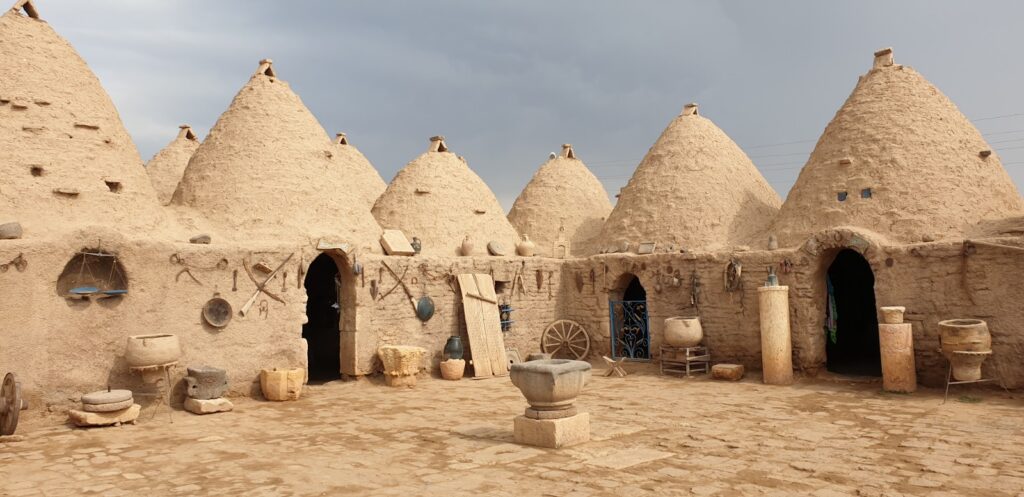
Beehive Houses in Syria are traditional dwellings built entirely from mud and straw, shaped into conical domes that resemble a beehive. Unlike modern houses that rely on wooden beams or steel reinforcements, these homes maintain their stability through the clever use of geometry and local natural materials. Their walls are thick, providing excellent insulation from the harsh desert heat in summer and cold in winter.
These houses are a perfect example of sustainable architecture. Built with locally sourced earth, they require minimal resources and blend harmoniously with the surrounding landscape. Their design is not only functional but also aesthetically striking, making them a unique cultural symbol of rural Syria.
Historical and Cultural Context
While the Beehive Houses in Syria are not ancient in the archaeological sense—most date back only a few centuries—they represent a deeply rooted tradition of rural Syrian architecture. They have been homes to farming families, herders, and small rural communities, especially in the semi-arid steppe regions.
The construction technique was passed down through generations, relying on the knowledge of natural building methods that minimize environmental impact. Unlike monumental stone buildings or ornate palaces, these homes speak to the daily lives of ordinary people, their relationship with the environment, and their resourcefulness.
Where Are They Found?
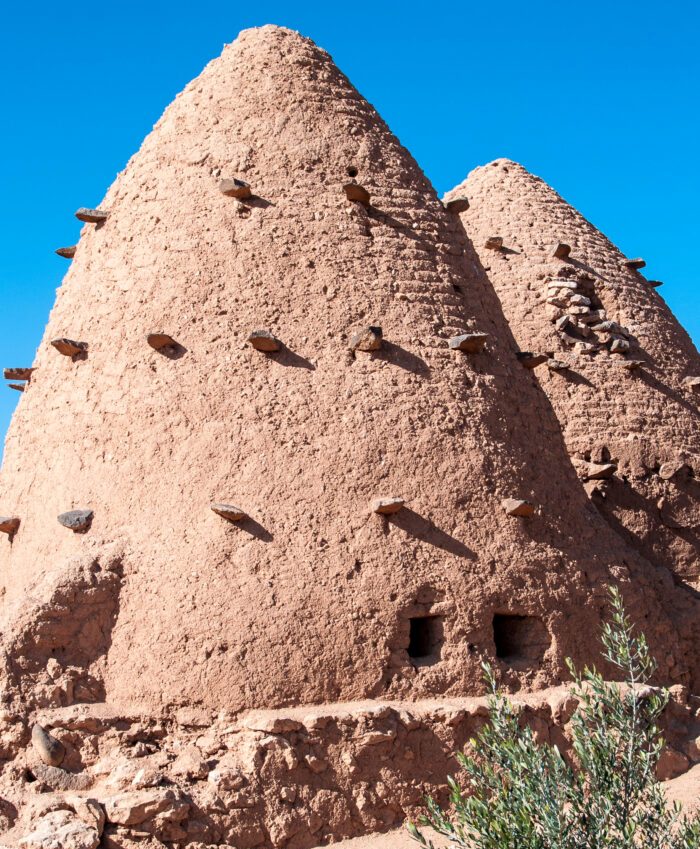
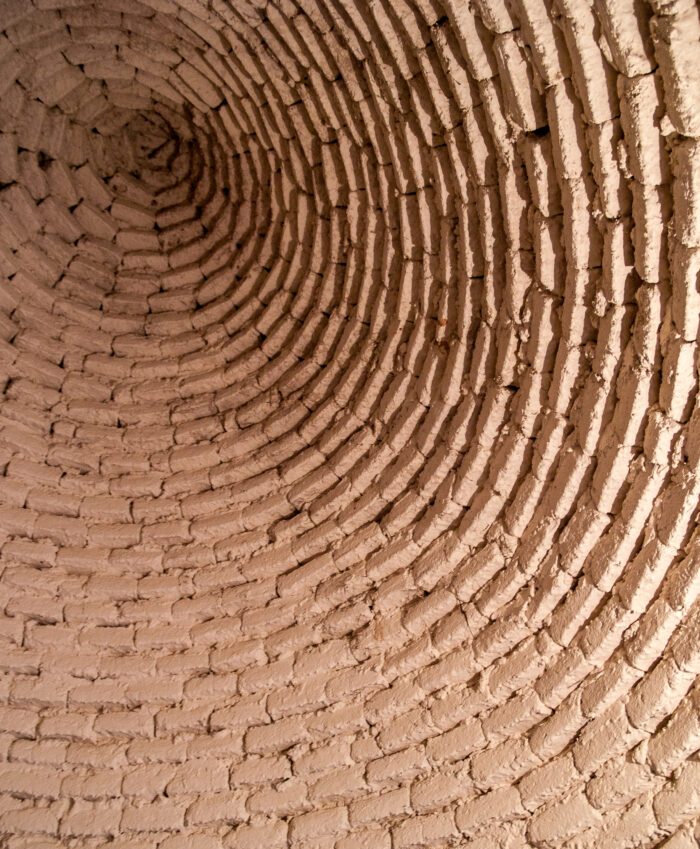
The largest concentration of Beehive Houses in Syria is found in the eastern countryside of Hama Governorate, around the town of Salamiyah. Villages such as Sarouj, Tel Al-Tut, Hammadi Omar, Jarouh, and Al-Qastal are known for their dense clusters of these mud domes.
Estimated Numbers and Area
Researchers and architectural surveys estimate that in the Salamiyah countryside alone, there are over 1,500 individual beehive domes forming approximately 200 to 300 traditional housing units. These structures typically cluster together, creating compact neighborhoods that can cover areas between 1 to 2 square kilometers.
While exact figures vary due to the lack of official censuses and ongoing conflict-related damage, these estimates provide a sense of scale for this remarkable architectural phenomenon.
Construction Techniques
The construction of Beehive Houses in Syria involves no nails, wood, or metal. Instead, builders use:
- Mud and clay mixed with straw or other organic fibers to form adobe bricks or to be directly applied in layers.
- The walls are built in a circular shape, gradually tapering to form a conical dome.
- The dome shape efficiently transfers weight downwards, giving the structure natural strength and stability.
- Openings such as doors and windows are small to maintain the thermal efficiency and structural integrity.
- Roofs often include a small opening at the top for ventilation and light.
The absence of timber is particularly important in these regions, where wood is scarce or expensive. The design also reflects an acute awareness of the climate—keeping interiors cool in the summer and warm in the winter.
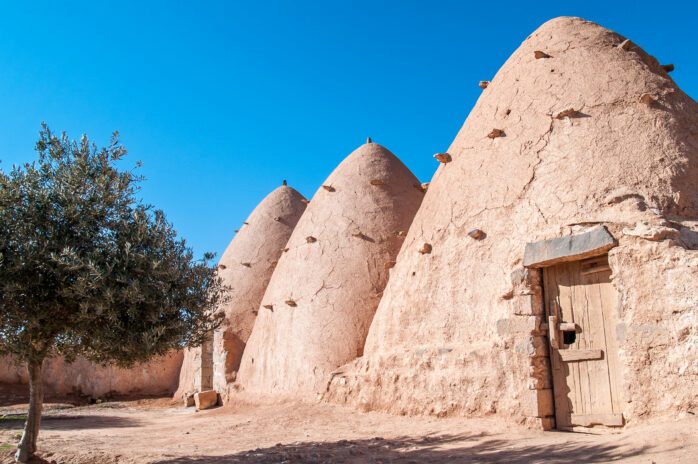
Current Status and Usage
Historically, these homes were widely inhabited, but today most Beehive Houses in Syria are abandoned or used for storage and animal shelters. Urbanization, modernization, and socio-political upheaval have led many residents to move to cities or modern buildings.
In some cases, local families still occupy these homes, especially among communities with limited economic means. There have been efforts by heritage organizations and architects to document, preserve, and sometimes restore these buildings due to their cultural value.
Importance and Recognition
Though not ancient monuments, Beehive Houses in Syria have gained attention among architects, historians, and environmentalists for several reasons:
- They represent one of the few surviving examples of vernacular architecture adapted perfectly to harsh climates without relying on modern technology.
- Their construction techniques align with principles of sustainable and green building, inspiring contemporary architects worldwide.
- They are a cultural emblem of Syria’s rural heritage, offering insight into traditional lifestyles often overshadowed by the country’s grander historical narratives.
Tourism Potential
With their unique appearance and cultural significance, Beehive Houses have potential as a niche tourism attraction. Travelers interested in cultural heritage, architecture, and rural life can find these sites compelling.
However, challenges remain:
- The remote location and lack of tourist infrastructure make visiting difficult.
- Many houses are in poor condition due to neglect, natural decay, or damage during conflicts.
- There is limited awareness internationally of their existence.
Despite these challenges, some local initiatives promote cultural tourism and environmental awareness, hoping to integrate Beehive Houses into broader heritage trails around Hama and Salamiyah.
Challenges and Preservation
The survival of Beehive Houses faces threats such as:
- Urban migration, which reduces local populations maintaining traditional homes.
- Natural erosion due to rain and wind exposure on mud structures.
- Neglect and lack of maintenance due to economic hardship.
- Conflict-related damage over the past decade.
Preservation efforts focus on:
- Documentation and mapping of existing structures.
- Raising awareness locally and internationally.
- Encouraging restoration projects using traditional methods.
- Promoting eco-tourism that supports local communities.
Conclusion
Beehive Houses in Syria are a remarkable example of how architecture can emerge from necessity, environment, and tradition. These mud domes tell stories of resilience, adaptation, and cultural identity. They may not be grand palaces or ancient temples, but they offer a rare and intimate glimpse into Syria’s living heritage.
For travelers seeking authentic and meaningful experiences, exploring the Beehive Houses in Syria is an opportunity to step back into a timeless way of life, appreciating human creativity in harmony with nature.
Finally.. If you have any questions, please contact us. To explore further, visit our Facebook Syria collection for rare images and cultural highlights.
Sources & References:
UNESCO – World Heritage Centre: https://whc.unesco.org
Archnet – Architecture & Heritage Database: https://www.archnet.org
World History Encyclopedia: https://www.worldhistory.org
Syrian Heritage Archive Project: https://syrian-heritage.org
Global Encyclopedia: Wikipedia



